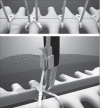Biomechanical analysis of the FlatWire Figure 8 sternal fixation device
- PMID: 25332648
- PMCID: PMC4173867
Biomechanical analysis of the FlatWire Figure 8 sternal fixation device
Abstract
Objective: To determine whether the FlatWire Figure 8 sternal fixation device (Penn United, USA) is mechanically superior to the current standard in sternotomy closure.
Description: Unstable sternal closure using traditional steel-wire cerclage can increase postoperative pain, bony cut-through and wound dehiscence. The authors present the Figure 8 sternal fixation device to minimize these complications. Biomechanical properties of the device were compared with conventional steel wire sternal repair.
Evaluation: Using two constructs of both FlatWire and steel wire, pull-to-failure, Hertzian contact and cut-through were compared. Samples were tested to 500,000 cycles or failure. Cyclic comparisons were performed using log-rank t tests and Student's t tests for cut-through analysis. FlatWires were found to have superior biomechanical properties in all categories tested.
Conclusion: The FlatWire provides superior biomechanical properties compared with conventional steel wire, which may lead to reduced sternal wound complications.
Objectif: Déterminer si le dispositif de fixation du sternum FlatWire Figure 8 (Penn United, États-Unis) est mécaniquement supérieur à la norme actuelle pour la fermeture des sternotomies.
Description: La fermeture du sternum au moyen du cerclage classique en fil d’acier peut accroître la douleur postopératoire, l’insertion osseuse et la déhiscence de la plaie. Les auteurs présentent le dispositif de fixation du sternum Figure 8 pour réduire ces complications au minimum. Les auteurs ont comparé les propriétés biomécaniques du dispositif à la réparation sternale classique à l’aide d’un fil d’acier.
Évaluation: Les auteurs ont comparé le test de tension, le contact hertzien et l’insertion du modèle FlatWire à celui du fil d’acier. Ils ont comparé les échantillons jusqu’à 500 000 cycles ou jusqu’à l’échec. Les comparaisons cycliques ont été effectuées au moyen de tests t de Mantel-Haenzel et de tests t pour l’analyse de tension. Le modèle FlatWire avait des propriétés biomécaniques supérieures dans toutes les catégories mises à l’essai.
Conclusion: Le FlatWire a des propriétés biomécaniques supérieures à celles du fil d’acier classique, lesquelles peuvent réduire les complications de la plaie du sternum.
Keywords: Figure 8; FlatWire; Sternal fixation; Sternal wound; Sternotomy.
Figures




References
-
- Shih CC, Shih CM, Su YY, Lin SJ. Potential risk of sternal wires. Eur J Cardiothorac Surg. 2004;25:812–8. - PubMed
-
- Ståhle E, Tammelin A, Bergström R, Hambreus A, Nyström SO, Hansson HE. Sternal wound complications – incidence, microbiology and risk factors. Eur J Cardiothorac Surg. 1997;11:1146–53. - PubMed
-
- Ridderstolpe L, Gill H, Granfeldt H, Ahlfeldt H, Rutberg H. Superficial and deep sternal wound complications: Incidence, risk factors and mortality. Eur J Cardiothorac Surg. 2001;20:1168–75. - PubMed
-
- Losanoff JE, Collier AD, Wagner-Mann CC, et al. Biomechanical comparison of median sternotomy closures. Ann Thorac Surg. 2004;77:203–9. - PubMed
-
- Casha AR, Gauci M, Yang L, Saleh M, Kay PH, Cooper GJ. Fatigue testing median sternotomy closures. Eur J Cardiothorac Surg. 2001;19:249–53. - PubMed
LinkOut - more resources
Full Text Sources
Other Literature Sources
